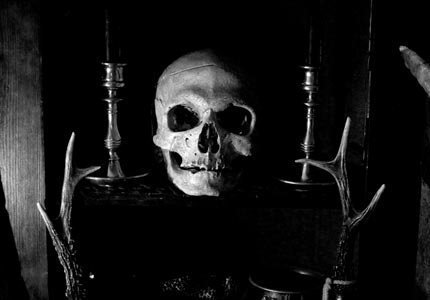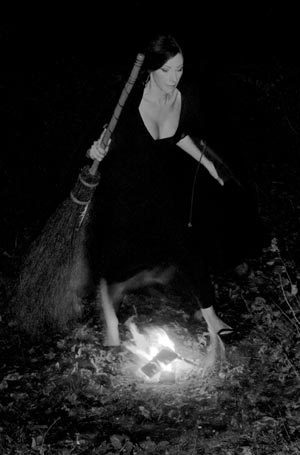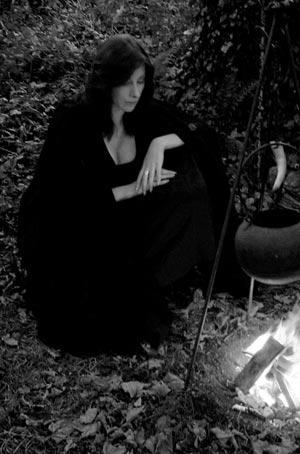An Interview with a Cornish Witch
Interview with Gemma Gary for Silhouette Magazine by Amy Chessman
Photography by Jane Cox

Witchcraft is one thing that is left undiscovered, but why? It has been existent in the world for as long as we know, how come we don’t know much about the practice?
We have all experienced alternative life guidance at some point, whether it be browsing the horoscopes, or hearing about someone who has been to see a psychic, medium or a clairvoyant. Yet, we rarely know of someone who has received a reading or charms from a white witch. We see in the media that witches are still being tortured in other countries but, there is barely a mention about people that practice witchcraft in the UK. Are we scared to find out or are we just playing ignorance?
The stories we hear about ‘black witches’ has definitely left a dark mark against the practice of white witches. Whatever the reason, the negative stigma should be removed.
The existence of magic and spirit phenomena has always been something that has fascinated me, but I haven’t had the chance to explore the world of witchcraft until now. I have found Gemma Gary who pursues a practice of predominantly Cornish, and West Country folk-ceremonial witchcraft to answer a few questions for us.
AC. Thank you very much for participating in this interview. Give us some information about the witchcraft you follow.
GG. There are various practices and traditions that are considered to be ‘witchcraft’. The form of Craft I practice could be described as being what has come to be known as ‘traditional witchcraft’ or ‘Old Craft’, but even these terms mean different things to different practitioners who identify with them; so one cannot be dogmatic or generalise about it. For me, these terms refer to a Craft that draws upon the folk-magical traditions and historical witch-beliefs of one’s locality, in addition to the common ‘threads’ or ‘keys’ to be found in traditional witchcraft practices throughout the country. Living in the West Penwith region of Cornwall, this means I study and pursue a practice of predominantly Cornish, and West Country folk-ceremonial witchcraft. Folk-magical practitioners in Cornwall were known variously as ‘white witches’, ‘conjurors’, ‘charmers’ etc. and one term used in particular in Cornwall was ‘Pellar’; thought by some to be derived from a ‘repeller’ or ‘expeller’ of evil, although there are other interesting theories. This is a very ‘hands on’ practice of operative, or results-based witchcraft, in which charms may be created or spells performed to resolve all manner of needs; be they for matters concerning love, health, prosperity, protection, healing, curse lifting etc. Also there are the various oracular and divinatory methods, to seek answers or guidance. This operative Craft is not without its spiritual side, for it may be said to be ‘fuelled’ by devotional and mystical observance.
AC. How did you decide to become a witch?
GG. It is a moot point whether one can become a witch or is born to it, and I’m not entirely decided about this. I always had an inclination toward such things, and grew up in a family with a prevailing acceptance of the ‘spirit world’ and a fairly animistic outlook. I was a very strange child; extremely shy and happiest in moments of solitude; especially in wild or wooded places with my mind on otherworldly matters. Nature, wildlife, spirits and animals were my preferred company and I felt very separate and ‘other’ from the children and adults around me – the witch is a figure who has always existed very much on the periphery, or even entirely ‘beyond the pale’ of everyday society. History, folklore, superstition and magic fascinated me, and I was fortunate that some of the schools I attended held interesting books relating to these subjects, and even directly to witchcraft, in their libraries. I was fourteen or fifteen when I consciously decided to begin serious study of witchcraft practice. The only accessible information concerning actual witchcraft practice, tended to relate the Craft of the ‘Wica’; a form of witchcraft developed, possibly from earlier practices, in the late 40’s and 1950’s. Whilst I took well to some aspects of this Craft, much of it just didn’t seem to fit with my own thoughts on how witchcraft should ‘feel’ and had ‘haunted’ me from early childhood. And so I worked instinctively; merging those things I took to from the modern Craft literature, my own ideas, and, importantly, what I could glean from Cornish witch-lore. I went on to meet and work with and learn from a number of witches and occultists, but it wasn’t until I was entering adulthood that I encountered the elderly male leader of a traditional covine of witches that met in a beautiful wooded valley in West Cornwall. It wasn’t too long before I was invited to attend one of their ‘meets’, and it was in their rites that I discovered that incommunicable and instantly familiar ‘feel’ of what was to me real witchcraft. I also discovered much that was strikingly in line with my own instinctive practices, which served as a wonderful confirmation that I had been doing it right! In time, I was ritually passed the virtue to lead the covine myself, and have experienced a number of initiations into Traditional Craft ‘streams’, and today I still serve as ‘leader’ of a small covine in West Cornwall.
AC. How does one become a witch?
GG. Firstly one has to have the natural inclination. I feel one also has to develop and nurture the ability to seek instruction, wisdom and inspiration from the lonely wild places and the countryside. Here, via instinctive and open practice, one may well have encounters with spirit, and even the ‘Old One’. Then there is the studying of textual information, but the prior approach is the more important and without it, one cannot be a witch. One may dedicate oneself as a witch, or receive initiation into the Craft via apprenticeship to another practitioner, or via admission to a witch covine. In Cornish folklore, there are interesting traditions that one can become a witch by rescuing a stranded mermaid and bargaining with her for power in return, or by attending holy communion, and hiding away the wafer, to feed later at midnight to the Devil who will appear in the form of a giant toad, or by climbing onto a logan stone (rocking stone) nine times without causing it to move. Whilst I can’t claim to have rescued a stranded mermaid, I have been through rather hair-raising rites relating to the other two methods.

AC. How can someone find out more about being a witch?
GG. Today there is a bewildering array of books available exploring the ways of witchcraft, although those that are worth reading are very few. I always recommend the books of witch and author Doreen Valiente to those seeking their first information on witchcraft; for her work straddles both traditional witchcraft and the Craft of the Wica. Despite also being a witchcraft author, I do echo her sentiment when she said: “I’d say to a person who really wanted to know what was the spirit of witchcraft, that they’ll learn more by, say, going out on the downs at midnight and listening to the wind in the trees and looking at the full moon; they’ll learn more of the spirit of witchcraft; the real spirit of witchcraft in that way than they will by reading any amount of books.”
Also, if one possibly can, I would strongly recommend that someone seeking to learn about what it is to be a witch makes a visit to The Museum of Witchcraft, in Boscastle, North Cornwall. This extraordinary museum contains a huge collection of witchcraft related artefacts and regalia; many relating directly to the traditional magic of Cornwall and the West Country. Many of these artefacts exude a very potent atmosphere, and collectively, they give the sensitive visitor a very good ‘feel’ for the Craft in its many forms, both light and dark.
AC. Describe the process of conducting a reading.
GG. Here I can only speak of my own approach to this, as every practitioner will have their own ways and methods. I prefer to give ‘distant’ readings as I’m not happy to be always on call or have strangers coming to my home like those who fall under the category of ‘village witches’. I’m a very shy, reclusive and private soul; besides, I doubt many clients would be happy to drive their cars down the long, narrow and bumpy lane that leads to my cottage – most people aren’t, and often seem to have great difficulty finding it! Traditional West Country witches do what I call ‘sending forth the spirit’, and so working with clients at a distance has never been a problem; be it for readings or other magical work, and there are many accounts of charmers stopping blood (when a person or animal has been wounded) or charming warts over great distance.
There are a number of things I make use of when doing a reading; I find the tarot a good and thorough tool, and alongside this I employ such things as ‘dark mirrors’ and ‘shew’ stones. Fire and smoke are also helpful visionary tools, but most important of all is the aid of what traditional practitioners call their ‘friends’; the spirit helpers or ‘familiars’. Many old time witches kept a human skull as the housing for such a ‘friend’, and I have an old human skull that I like to consult during visionary and oracular work.
AC. What kind of mind state do your clients have to be in?
GG. An ‘open’ state is most helpful. I like to let a client know the date, and approximately what time of day I will be doing their reading; this aids the process of ‘contact’, and allows them to naturally ‘link in’ and be open to the working.
AC. What are your clients’ usual responses to your readings?
GG. To date, all clients I have heard back from have reported that the guidance they have received has been very helpful, and some have had further question to ask. Others I never hear from, and going on the old saying that ‘no news is good news’ I must have a 100% success rate! In reality though of course, I can’t imagine that is actually the case.
AC. What type of rituals do you perform?
GG. Gosh, there are many types of ritual; from simple daily devotions, to magical rites for all manner of needs, up to celebratory and devotional covine rites. For magical rites, the moon is very important. In its waxing tide to full, it is a good time to work for increase, empowerment, the encouragement or conjuration of things desired, and other generative workings. On the moon’s waning tide to dark, it is conversely a good time for banishment, diminishment and exorcising of all things undesirable, and in certain cases for cursing, or ‘owl blinking’ as we call it in the West Country.

AC. How do you maintain your abilities?
GG. ‘Use it or loose it’ and ‘practice makes perfect’ are phrases that come to mind here. Working with the cyclic nature of things; the tides of the moon and of the seasons, the accumulative experience of mystical insights and spirit phenomena in ones practice, and fully living one’s Craft at all times nurtures a potent inner magical awareness. Potency, virtue and wisdom may be found in the land, as mentioned previously, and so the witch walks the land in pilgrimage to imbibe of these things, to be drawn upon and utilised later when needed.
What holidays do witches celebrate?
The cyclic seasonal story of birth, growth, zenith, repose, death, nadir, and rebirth, are of great importance to witches, and in the various traditions there are ‘high nights’ or ‘holy nights’ that mark these times in the journey of the year. In my own practice I observe Candlemas, May’s Eve, Golowan – the Cornish midsummer festival and feast of St John, Guldize – the harvest end ‘feast of ricks’, Allantide – the Cornish Hallowe’en, and Montol – the Cornish midwinter festival.
AC. Do you worship gods and/or goddesses, and if so, how do you worship?
GG. Whilst witchcraft is not a religion, nor do witches necessarily have to align themselves with any particular religion or spiritual philosophy, in Britain, and elsewhere in Europe, witches and folk-magical practitioners have traditionally operated within a curious, but not entirely contradictory, observance of Christianity and Paganism. The Divine is the Divine, and no living human, or their religions, can fully comprehend its true nature. The witch will call upon aspects, manifestations and perceptions of the Divine Truth; the ‘Ancient Providence’ and Primogenitrix of all, in accordance with their tradition or the nature of their Craft. Within my own tradition, working with the cyclic, tidal and dualistic forces of nature, we work with the old Cornish manifestation of the Horned Spirit/Deity – The Bucca – being a Deity of the weather and tidal forces, and both light and dark in nature. Witch rites of worship are rites of Love, Beauty and Truth, and it is through The Bucca that we seek experiential phenomena and glimpses of the Divine Truth; for all goddesses and gods are fragments of that Truth.
AC. How does spirituality enter your domestic life?
GG. One tries to cultivate a permanent spiritual awareness, and within domestic life there are a variety of ways in which I interact with spirit. Through daily simple devotions and meditations at the hearth are maintained an awareness of ‘one-pointedness’; an awareness that ‘all is one’. Household charms need to be maintained through their regular acknowledgement, and household spirits kept happy through the provision of sustenance and comfort via hearthside rites of offering.
AC. What are your favourite aspects of witchcraft?
GG. That is a lovely question, and a happy one for me to think upon. Whilst, like all things, it has its costs, there are many wonderful benefits. Enjoying an inner, working relationship with the landscape around me and the spirits of place, the pleasure of solitude and the joy of the company of the covine family, the awesome experience of spirit phenomena, the satisfaction in helping others, sharing one’s home with some extraordinary spirit-filled items and living a far from ordinary life… these are a few of my favourite things!
